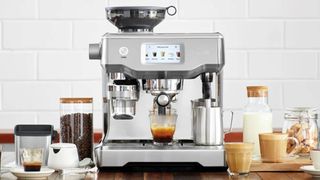Learning how to make espresso at home opens up a whole up-to-date world of possibilities, allowing you to take your coffee drinking to the next level. You can also save money in the long run if you regularly buy espresso from a coffee shop.
Making espresso can be quite arduous to master, and if you have recently purchased an espresso machine such as Breville/Sage Bambino Plusyou might have trouble recreating the wealthy, obscure espresso and chunky crema you see in coffee shops. Fear not: learning the basics is actually quite uncomplicated, and this guide will teach you how to apply an espresso machine like a pro in no time.
In this tutorial, we will cover making espresso using pump espresso machines, rather than using stovetop espresso machines or Nespresso machinesIn summer, you can also apply our tips on how to prepare iced coffee in 4 uncomplicated steps.
How to make espresso in just 4 steps
Here are the main steps for making espresso at home:
- Choose the coffee beans that are best for you
- Grind coffee beans for the perfect result
- Employ a coffee tamper to create a disc
- Experiment to find the best flavor
1. Which coffee beans are best for espresso?
(Graphics: © Pexels)
If you’re up-to-date to this, you’ve probably heard that exorbitant, specialty beans are a must. While it’s true that higher quality beans often produce a better product, it’s perfectly fine to apply fewer premium beans to make a great cup of coffee. Just make sure you’re choosing whole beans or pre-ground beans that are ground for espresso. Pre-ground beans from the grocery store are often too rugged for espresso, which we’ll talk about a bit later, and if the package doesn’t include a roast date, there’s no way to know how fresh the coffee is.
The choice is yours. Just make sure you buy beans roasted specifically for espresso—not for a filter or French press.
2. How to Grind Coffee Beans for Espresso

(Graphics: © Pexels)
The fineness of the coffee grind determines its resistance to the espresso pump, changing the time the coffee is exposed to and then boiled by the pressure and heated water – this affects the taste, body and strength of the espresso. A finer grind will provide more resistance, which translates into greater extraction of the coffee compounds because the coffee is exposed to heat, water and pressure for longer. It is significant that the coffee is ground evenly to ensure consistent extraction and results.
Many coffee machines have a built-in grinder, but you can often have a separate one. If you have a grinder, aim for a coarser grind than you would for ground coffee (like Turkish coffee) but a finer grind than you would for a drip coffee maker or French press. Getting the grind right, also known as “fine-tuning,” takes trial and error, and the grinder settings will vary from bean to bean and even from batch to batch of the same bean. We’ll discuss this trial and error process in more detail later. If you don’t have a grinder, many local coffee shops will grind beans for you, although usually only the ones you buy from them.
Grocery store ground coffee is usually too rugged for pump espresso, resulting in slim, watery coffee with no crema. Helpfully, some coffee machines come with double-walled pressurized baskets that facilitate boost the pressure on the coffee puck, allowing for a coarser grind—which will make a great cup of coffee, but won’t give you the texture or flavor of a “real” espresso.
3. Weigh and tamp the ground coffee

(Graphics: © Pexels)
Once you’ve ground your beans, you’ll need to throw them into the filter holder basket that came with your coffee maker. Weighing the amount of coffee you’re using is a good idea to ensure consistency in each shot. The amount of coffee also affects the resistance of the disc to pressure.
A typical starting point is 0.32 ounces (9 g) for a single shot and 0.64 ounces (18 g) for a double, although if your coffee machine suggests a scale, apply that. A good set of highly right espresso scales is useful here to keep things consistent, and coffee scales with a shot timer are readily available for under $20. Look for one that is right to 0.1 g.
Employ a coffee tamper—often supplied with espresso machines—to press the coffee firmly into the puck. This affects the resistance of the puck, so make sure you press evenly to achieve consistency from shot to shot. You may need to adjust the tamping pressure depending on how your espresso takes later.
Consider investing in tamping mat to make sure that the filter holder remains stable and you do not damage it or the countertop while whisking.
4. How to pour espresso

(Graphics: © Pexels)
Before you start, make sure you have a waste or food container on hand to dispose of the grounds. Be careful with the heated disc so as not to burn yourself.
A good shot will have the viscosity of runny honey and should be golden brown in color. If you are using a set of coffee scales, which we recommend, place them under your glass or cup and pour until you have twice the weight of coffee you have poured in. This usually takes about 30 seconds, and you should time your pour to make sure you are taking a similar amount of time to pour each one. Taste your espresso and see what you think.
This is where your previous consistency pays off. It’s unlikely you’ll get a perfect shot. It could be too slim, too bitter, or too sour. You may have used too much or too little coffee. In general, aim for an espresso that balances the flavor profile of your chosen beans. Expect bitterness with wealthy, chocolatey notes in obscure roasts. Expect more sweetness and acidity with floral or fruity notes in medium and airy roasts.
Flavors should be balanced, so if you have an overwhelming bitterness or acidity, that’s a sign of over or under extraction, basically too much or too little brewing. If your shot is struggling or produces very little liquid, your grind is too fine. If there’s too much liquid, your grind is too rugged.
Play around with the grind of your coffee, as this is often the most likely cause of extraction problems, keeping all other inputs the same, including the beans and weight of coffee used, tamping pressure, brewing time and ratio. If that doesn’t work, try adjusting the other factors individually until you get the perfect espresso. It takes some time, but it’s definitely worth it once you get the hang of it.
If you feel like you’ve overdone it with espresso, don’t worry. Our best coffee machines offer a range of machines that will make your morning brewing easier.
You can also learn how to make summer treats like ice cream without having an ice cream maker at home.
